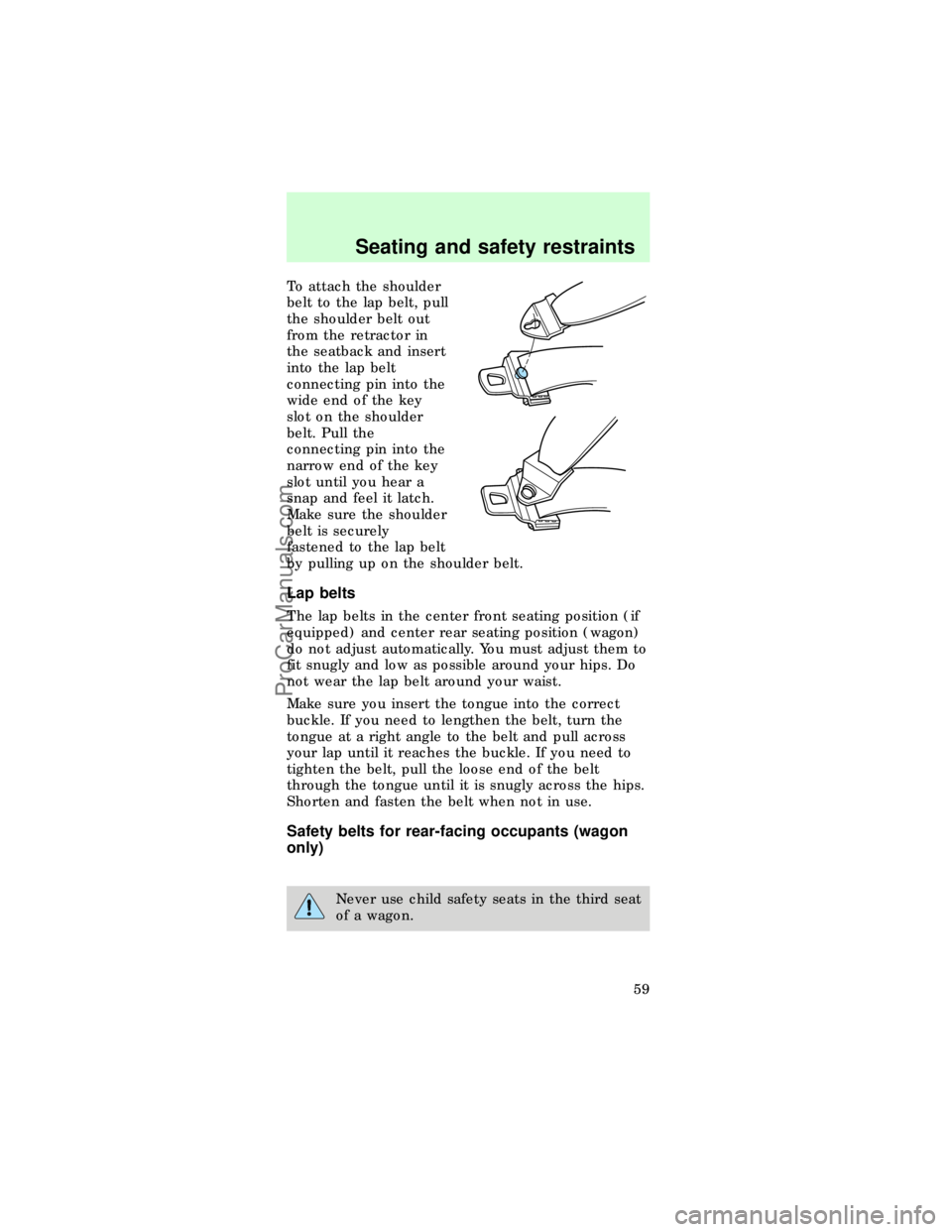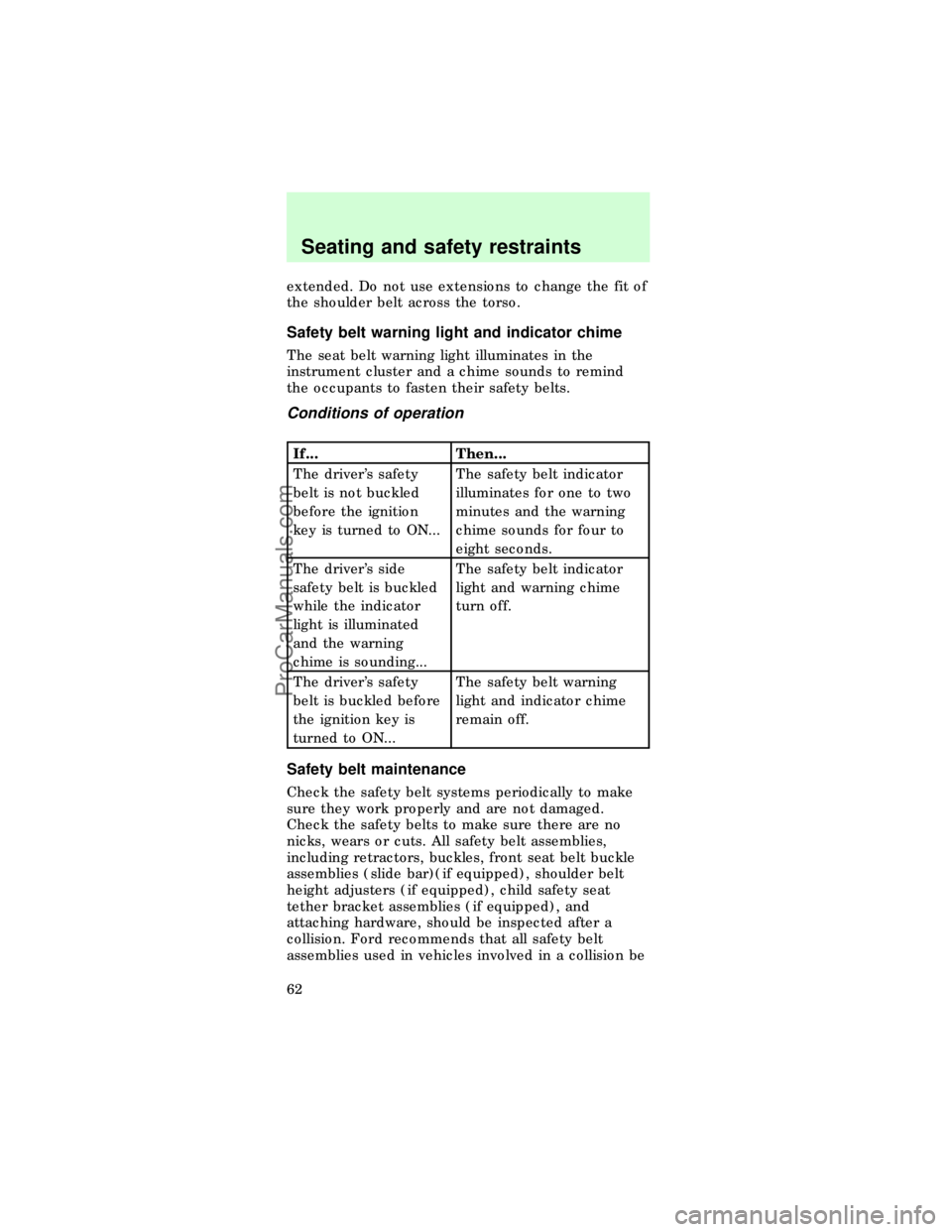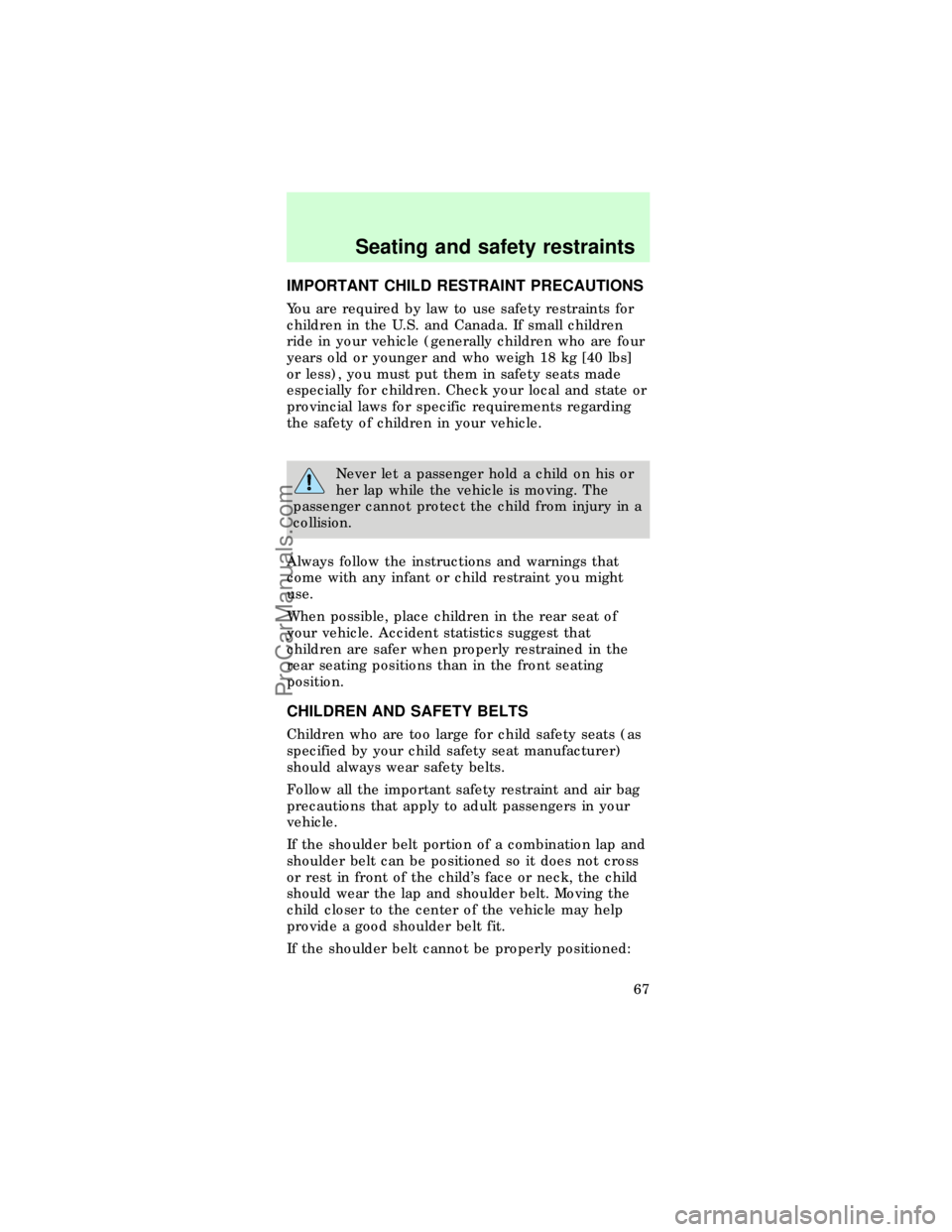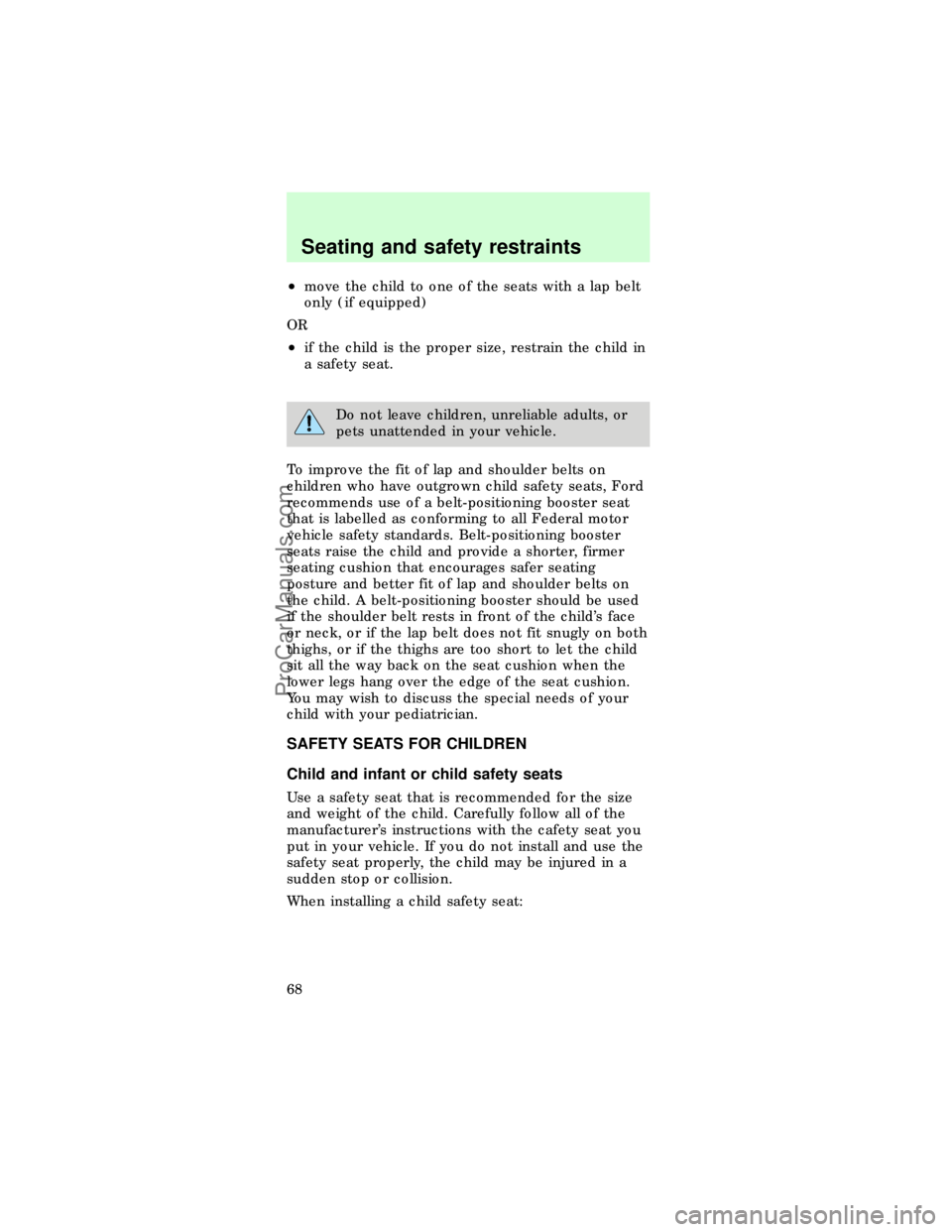Page 54 of 167

SAFETY RESTRAINTS
Safety restraints precautions
Always drive and ride with your seatback
upright and the lap belt snug and low across
the hips.
To prevent the risk of injury, make sure
children sit where they can be properly
restrained.
It is extremely dangerous to ride in a cargo
area, inside or outside of a vehicle. In a
collision, people riding in these areas are more
likely to be seriously injured or killed. Do not allow
people to ride in any area of your vehicle that is
not equipped with seats and safety belts. Be sure
everyone in your vehicle is in a seat and using a
safety belt properly.
Combination lap and shoulder belts
1. To fasten, insert the
tongue into the slot in
the buckle.
2. To unfasten, push
the red release button
and remove the tongue
from the buckle.
The outboard safety restraints in the vehicle are
combination lap and shoulder belts. The front and
rear seat passenger outboard safety belts have two
types of locking modes described below:
Seating and safety restraints
55
ProCarManuals.com
Page 55 of 167
To test the vehicle
sensitive (emergency)
locking mode, pull the
shoulder belt quickly to
lock.
The vehicle sensitive mode is the normal retractor
mode, adjusting shoulder belt tightness in response
to vehicle movement. For example, if the driver
brakes suddenly or turns a corner sharply or the
vehicle receives an impact of 8 km/h (5 mph) or
more, the combination safety belts would lock to
help reduce forward movement of the driver and
passengers.
Automatic locking mode
In this mode, the shoulder belt is locked in a certain
position by the occupant anddoes notadjust
tightness during vehicle movement.
The automatic locking mode is not available on the
driver belt.
When to use the automatic locking mode
²When a tight lap/shoulder fit is desired.
²Any timea child safety seat is installed in the
vehicle. Refer toChildren and infant or Child
safety seatslater in this chapter.
Seating and safety restraints
56
ProCarManuals.com
Page 58 of 167

To attach the shoulder
belt to the lap belt, pull
the shoulder belt out
from the retractor in
the seatback and insert
into the lap belt
connecting pin into the
wide end of the key
slot on the shoulder
belt. Pull the
connecting pin into the
narrow end of the key
slot until you hear a
snap and feel it latch.
Make sure the shoulder
belt is securely
fastened to the lap belt
by pulling up on the shoulder belt.
Lap belts
The lap belts in the center front seating position (if
equipped) and center rear seating position (wagon)
do not adjust automatically. You must adjust them to
fit snugly and low as possible around your hips. Do
not wear the lap belt around your waist.
Make sure you insert the tongue into the correct
buckle. If you need to lengthen the belt, turn the
tongue at a right angle to the belt and pull across
your lap until it reaches the buckle. If you need to
tighten the belt, pull the loose end of the belt
through the tongue until it is snugly across the hips.
Shorten and fasten the belt when not in use.
Safety belts for rear-facing occupants (wagon
only)
Never use child safety seats in the third seat
of a wagon.
Seating and safety restraints
59
ProCarManuals.com
Page 61 of 167

extended. Do not use extensions to change the fit of
the shoulder belt across the torso.
Safety belt warning light and indicator chime
The seat belt warning light illuminates in the
instrument cluster and a chime sounds to remind
the occupants to fasten their safety belts.
Conditions of operation
If... Then...
The driver's safety
belt is not buckled
before the ignition
key is turned to ON...The safety belt indicator
illuminates for one to two
minutes and the warning
chime sounds for four to
eight seconds.
The driver's side
safety belt is buckled
while the indicator
light is illuminated
and the warning
chime is sounding...The safety belt indicator
light and warning chime
turn off.
The driver's safety
belt is buckled before
the ignition key is
turned to ON...The safety belt warning
light and indicator chime
remain off.
Safety belt maintenance
Check the safety belt systems periodically to make
sure they work properly and are not damaged.
Check the safety belts to make sure there are no
nicks, wears or cuts. All safety belt assemblies,
including retractors, buckles, front seat belt buckle
assemblies (slide bar)(if equipped), shoulder belt
height adjusters (if equipped), child safety seat
tether bracket assemblies (if equipped), and
attaching hardware, should be inspected after a
collision. Ford recommends that all safety belt
assemblies used in vehicles involved in a collision be
Seating and safety restraints
62
ProCarManuals.com
Page 63 of 167
Do not attempt to service, repair, or modify
the Air Bag Supplemental Restraint System
or its fuses. See your Ford or Lincoln-Mercury
dealer.
CHILDREN AND AIR BAGS
For additional important safety information, read all
information on safety restraints in this guide.
Children should always wear their safety belts.
Failure to follow these instructions may increase the
risk of injury in a collision.
Rear-facing
child seats or
infant carriers should
never be placed in
the front seats.
HOW DOES THE AIR BAG SUPPLEMENTAL
RESTRAINT SYSTEM WORK?
The SRS is designed to
activate when the
vehicle sustains
sufficient longitudinal
deceleration, similar to
hitting a fixed barrier
head on at 12±24 km/h
(8±14 mph).
The fact that the air
bags did not inflate in
a collision does not
mean that something is
Seating and safety restraints
64
ProCarManuals.com
Page 66 of 167

IMPORTANT CHILD RESTRAINT PRECAUTIONS
You are required by law to use safety restraints for
children in the U.S. and Canada. If small children
ride in your vehicle (generally children who are four
years old or younger and who weigh 18 kg [40 lbs]
or less), you must put them in safety seats made
especially for children. Check your local and state or
provincial laws for specific requirements regarding
the safety of children in your vehicle.
Never let a passenger hold a child on his or
her lap while the vehicle is moving. The
passenger cannot protect the child from injury in a
collision.
Always follow the instructions and warnings that
come with any infant or child restraint you might
use.
When possible, place children in the rear seat of
your vehicle. Accident statistics suggest that
children are safer when properly restrained in the
rear seating positions than in the front seating
position.
CHILDREN AND SAFETY BELTS
Children who are too large for child safety seats (as
specified by your child safety seat manufacturer)
should always wear safety belts.
Follow all the important safety restraint and air bag
precautions that apply to adult passengers in your
vehicle.
If the shoulder belt portion of a combination lap and
shoulder belt can be positioned so it does not cross
or rest in front of the child's face or neck, the child
should wear the lap and shoulder belt. Moving the
child closer to the center of the vehicle may help
provide a good shoulder belt fit.
If the shoulder belt cannot be properly positioned:
Seating and safety restraints
67
ProCarManuals.com
Page 67 of 167

²move the child to one of the seats with a lap belt
only (if equipped)
OR
²if the child is the proper size, restrain the child in
a safety seat.
Do not leave children, unreliable adults, or
pets unattended in your vehicle.
To improve the fit of lap and shoulder belts on
children who have outgrown child safety seats, Ford
recommends use of a belt-positioning booster seat
that is labelled as conforming to all Federal motor
vehicle safety standards. Belt-positioning booster
seats raise the child and provide a shorter, firmer
seating cushion that encourages safer seating
posture and better fit of lap and shoulder belts on
the child. A belt-positioning booster should be used
if the shoulder belt rests in front of the child's face
or neck, or if the lap belt does not fit snugly on both
thighs, or if the thighs are too short to let the child
sit all the way back on the seat cushion when the
lower legs hang over the edge of the seat cushion.
You may wish to discuss the special needs of your
child with your pediatrician.
SAFETY SEATS FOR CHILDREN
Child and infant or child safety seats
Use a safety seat that is recommended for the size
and weight of the child. Carefully follow all of the
manufacturer's instructions with the cafety seat you
put in your vehicle. If you do not install and use the
safety seat properly, the child may be injured in a
sudden stop or collision.
When installing a child safety seat:
Seating and safety restraints
68
ProCarManuals.com
Page 68 of 167
²Use the correct
safety belt buckle
for that seating
position.
²Make sure the
tongue is securely
fastened in the
buckle.
²Keep the buckle release button pointing up and
away from the safety seat, with the tongue
between the child seat and the release button, to
prevent accidental unbuckling.
²Place seatback in upright position.
²Put the safety belt in the automatic locking mode.
Refer toUsing the automatic locking mode.
Ford recommends the use of a child safety seat
having a top tether strap. Install the child safety seat
in a seating position which is capable of providing a
tether anchorage. For more information on top
tether straps, refer toAttaching safety seats with
tether straps.
Carefully follow all of the manufacturer's
instructions included with the safety seat
you put in your vehicle. If you do not install and
use the safety seat properly, the child may be
injured in a sudden stop or collision.
Seating and safety restraints
69
ProCarManuals.com